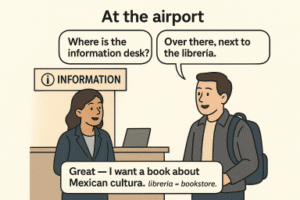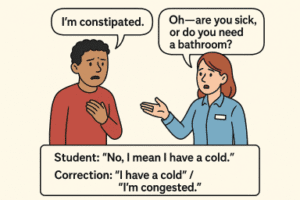🌟 Welcome to Cracking Cognates!
You already know more English than you think! Why? Because English and Spanish share thousands of words. These special words are called cognates.
✔️ Animal → animal
✔️ Doctor → doctor
✔️ Problema → problem
Pretty cool, right? Cognates are like shortcuts — they make learning English faster and easier.
But… watch out for false friends 👀
❌ Embarazada ≠ embarrassed (embarazada = pregnant!)
❌ Ropa ≠ rope (ropa = clothes)
This course will help you:
-
✅ Use true cognates with confidence.
-
❌ Avoid false cognates that trick many learners.
-
🤔 Understand similar cognates that change meaning in different situations.
-
🌍 Practice real-life English with reading, dialogues, and role-plays.
1. Introduction: real cognates, false cognates, and similar/partial cognates
1.1 What a cognate really is
-
Cognate = words in two languages that are related historically and therefore similar in form and meaning.
-
Because English borrowed heavily from Latin (often through French) and Spanish comes directly from Latin, many shared roots appear as similar-looking words.
1.2 Three precise categories
-
True cognates — look similar, sound similar, and mean the same thing in both languages. Safe to use (most of the time).
Example:familia → familycultura → cultureproblema → problem -
False cognates (falsos amigos) — look similar but mean something different (sometimes drastically different). These cause real communication errors.
Example: embarazada ≠ embarrassed (embarazada = pregnant). -
Partial / similar cognates — words that share a root but have diverged in meaning, register, or grammar. They require context.
Example: asistir (Spanish) vs assist (English). Asistir usually = attend; assist = help.
1.3 Why this matters for English learners
-
Fast gains: Recognizing cognates gives fast vocabulary growth for reading and listening.
-
Risk: False cognates can cause embarrassing or even serious misunderstandings (e.g., saying you are embarazada when you meant embarrassed).
-
Strategy needed: Recognize patterns, check endings/prefixes, use context, and learn the most dangerous false friends.
1.4 Important morphological cues (mini-rulebook)
Common Spanish → English mappings (use these as “red flags” or “helping rules”):
|
Spanish ending |
Likely English ending |
Example (ES → EN) |
|---|---|---|
|
-ción |
-tion |
educación → education |
|
-dad / -tad |
-ty |
ciudad → city |
|
-mente |
-ly |
rápidamente → rapidly |
|
-oso / -osa |
-ous |
famoso → famous |
|
-ico / -ic |
-ic |
económico → economic |
|
-ía (noun) |
-y |
biología → biology |
|
-ista |
-ist |
artista → artist |
|
-able |
-able |
razonable → reasonable |
Note: These patterns are strong but not absolute — still use context.
Exercises (Section 1)
A. Quick identification (True or False):
-
problema — problem ( )
-
ropa — rope ( )
-
comunidad — community ( )
-
sensible — sensible ( )
B. Strategy reflection (write 1–2 sentences):
Describe one method you will use to check if a word is a true cognate or a false friend.
2. Real cognates: deep content, patterns, collocations, examples, and practice
2.1 Why true cognates are reliable
-
Historically unchanged meaning.
-
Often appear in academic, medical, legal, and technological vocabulary.
-
Great for skimming/guessing meaning when reading.
2.2 Thematic lists of useful true cognates (by field)
Use these for fast vocabulary building. Learn collocations after the single word.
Academia & Study
-
educación → education
-
universidad → university
-
investigación → investigation / research
-
teoría → theory
-
práctica → practice
Health & Medicine
-
salud → health (not a direct cognate but related)
-
hospital → hospital
-
medicina → medicine
-
paciente → patient
-
clínico → clinical
Business & Law
-
contrato → contract
-
empresa → enterprise / company (enterprise ~ empresa)
-
legal → legal
-
economía → economy
-
servicio → service
Everyday / General
-
idea → idea
-
problema → problem
-
información → information
-
teléfono → telephone
-
cultura → culture
2.3 Collocations & usage tips (very useful)
Knowing the collocations prevents awkward literal translations.
-
Make a decision (not do a decision).
— Spanish: tomar una decisión → make a decision (learn collocations: make / take vs tomar). -
Conduct research (not realize research).
— Spanish: realizar ≠ realize: realizar una investigación → carry out / conduct research.
2.4 Pronunciation & stress tips (for selected cognates)
-
university → /ˌjuː.nɪˈvɜːr.sə.ti/ ; Spanish universidad stress differs.
-
information → /ˌɪn.fɚˈmeɪ.ʃən/ ; Spanish información stress is last.
Practice: read aloud the list of cognates; notice where English places stress (often different) and link words to meaning, not only to spelling.
2.5 Rich reading passage (cognate-rich) — read and answer
- Find ten (10) cognates in the passage
Passage:
The university published an important report about culture and education. The research shows that family and community support are central to student success. The hospital and public services also play a role. This information is useful for any national policy.
2. Write one sentence in English summarizing the passage using at least three cognates.
2.6 Production task
Write a short paragraph (6–8 sentences) about your study or work that uses at least 8 true cognates from the lists above. Underline the cognates.
3. False cognates: long list, explanations, severity, real examples & memory tricks
3.1 What makes a false cognate “dangerous”?
-
Minor embarrassment (funny) vs. major miscommunication (medical/legal). Classify by severity:
-
Low: minor awkwardness (e.g., sopa for soap)
-
Medium: creates confusion (e.g., librería for library — you’ll go to wrong place)
-
High: may cause serious misunderstanding (e.g., embarazada for embarrassed in certain contexts)
-
3.2 Extended list of false cognates (common, high-value)
|
Spanish |
Looks like |
Real meaning |
|---|---|---|
|
embarazada |
embarrassed |
pregnant (HIGH risk) |
|
constipado |
constipated |
to have a cold (MEDIUM) |
|
ropa |
rope |
clothes (LOW) |
|
sopa |
soap |
soup (LOW) |
|
carpeta |
carpet |
folder (MEDIUM) |
|
librería |
library |
bookstore (MEDIUM) |
|
embarazar (v.) |
embarrass |
to impregnate (HIGH) |
|
asistir |
assist |
to attend (MEDIUM) |
|
éxito |
exit |
success (MEDIUM) |
|
sensible |
sensible |
sensitive (MEDIUM) |
|
realizar |
realize |
to carry out / perform (MEDIUM) |
|
introducir |
introduce |
to insert (not usually “present a person”) |
|
pretender |
pretend |
to intend / to try |
|
suceso |
success |
event / happening |
|
actual |
actual |
current (not “actual” as in true) |
|
educado |
educated |
polite / well-mannered (not always “educated”) |
|
apoyar |
to appear? (no) |
to support (don’t confuse with soportar) |
|
molestar |
molest |
to bother (not sexual in common Spanish usage) |
|
asistir a |
assist to |
attend (not help) |
|
carpeta |
carpet |
folder |
Note: The same Spanish word can be correct in some contexts but not in others — check usage.
3.3 Why these differences happened (short etymology)
-
Languages borrow and then meanings shift. The same Latin root may evolve differently in English and Spanish.
-
Social/cultural uses can change meaning over centuries.
3.4 Dialogues showing errors + corrections
Travel mistake:
-
Student: “I’m constipated.”
-
Staff: “Oh—are you sick, or do you need a bathroom?”
-
Student: “No, I mean I have a cold.”
Correction: “I have a cold” / “I’m congested.”
Work mistake:
-
Employee to boss: “I assisted the meeting yesterday.”
-
Boss (confused): “You helped? Or attended?”
Correction: “I attended the meeting yesterday.”
3.5 Memory tricks to remember dangerous false friends
-
Embarazada → embarazado contains bra: pregnancy → imagine a baby wearing a small bra… (silly mnemonic but memorable!).
-
Ropa → ropa sounds like “ropa-rack” → think of clothes rack.
-
Carpeta → contains pet → picture a pet under a folder (folder/briefcase).
-
Constipado → con + stipa — imagine a stuffy nose — congestion.
(Use vivid images — they stick.)
3.6 Practice: find & correct
Rewrite each sentence correctly:
-
“She is embarrassed because she is embarazada.” → ___________________
-
“Put your homework in the carpet.” → ___________________
-
“The new librería is close to my house.” (Is this correct?) → _________
4. Similar / Partial cognates: nuance, grammar, and usage pitfalls
4.1 What are partial/similar cognates?
Words that share a root but differ in exact meaning, register, grammatical behavior, or collocations.
Examples:
-
actual (ES) = current / present (EN actual = real / factual).
-
asistir (ES) = attend / be present (EN assist = help).
-
introducir (ES) = insert (EN introduce = present someone, so Spanish often uses presentar for that).
4.2 Common verb differences (grammar/valency)
-
Asistir (a) → asistir a la reunión = attend the meeting.
-
Assist in English often needs a direct object: assist the doctor = help.
-
-
Soportar → soportar = tolerate, endure.
-
Support in English = help/finance/back. So soportar a alguien is to tolerate someone, not to help them.
-
4.3 Prepositions and other small forms
-
Spanish verbs often pair with different prepositions compared to their apparent English cognates. Pay attention to preposition + verb collocations.
4.4 Strategies to resolve uncertainty
-
Context check: does the English meaning make sense in the situation?
-
Dictionary check: use a learner’s dictionary that gives examples of use.
-
Corpora / examples: search sentence examples (for self-study, write sample sentences and check).
-
Ask yourself: is this a collocation problem (e.g., make a decision vs do)?
5. Wrap-up: real-world examples, humor, learning plan, and final quiz
5.1 Short humorous dialogues (use in role-play)

At the airport
A: “Where is the information desk?”
B: “Over there, next to the librería.”
A: “Great — I want a book about Mexican cultura.”
(Teacher note: librería = bookstore, not library.)

At the doctor
Patient: “Doctor, I feel constipado.”
Doctor: “You mean you’re congested / have a cold?”
Patient: “Sí — I said constipated by mistake!” (laughs)

Job interview
Interviewer: “Do you have experience in customer service?”
Candidate: “Yes. I worked in a local empresa for three years and handled important problems.”
Interviewer: “Excellent — your profile is very professional.”
5.2 Intensive self-study plan (two-week micro-course)
A sample schedule for intensive study using this lesson:
-
Day 1: Read Sections 1–2. Do Section 2 exercises (reading + short writing).
-
Day 2: Study pronunciation tips; record yourself reading the cognate-rich passage.
-
Day 3: Read Section 3; memorize 20 high-risk false cognates (use flashcards).
-
Day 4: Practice corrections and role-play dialogues.
-
Day 5: Study Section 4 (partial cognates) + exercises.
-
Day 6–7: Mixed practice: do the full final quiz and review weak items.
-
Day 8–14: Use spaced repetition for false friends, write two short essays using cognates, have a language exchange using prompts.
5.3 Memory & study techniques (quick)
-
Anki / flashcards: one side Spanish word; the other side English + a sentence.
-
Context sentences: always learn the cognate in a sentence.
-
Pics + words: attach funny images to dangerous false friends.
-
Production over recognition: make sentences, not only translations.
Final word
Think of cognates as bridges between English and Spanish. Some bridges are strong and safe, some are shaky, and a few lead you to the wrong place. By the end of this course, you’ll know which bridges to cross with confidence, which ones to avoid, and which require caution.
Welcome to Cracking Cognates! © 2025 by Joe Ehman is licensed under CC BY-NC-SA 4.0